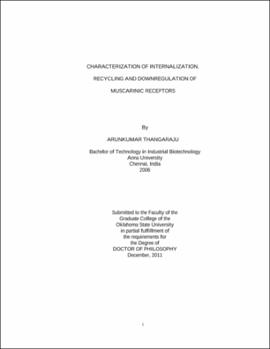| dc.contributor.advisor | Sawyer, Gregory W. | |
| dc.contributor.author | Thangaraju, Arunkumar | |
| dc.date.accessioned | 2013-11-26T08:22:59Z | |
| dc.date.available | 2013-11-26T08:22:59Z | |
| dc.date.issued | 2011-12 | |
| dc.identifier.uri | https://hdl.handle.net/11244/6678 | |
| dc.description.abstract | Scope and Method of Study: Muscarinic receptors mediate the responses elicited to the activation of the parasympathetic nervous system. Specifically, muscarinic receptors mediate exocrine glandular secretion, smooth muscle contraction and decreased heart rate and contractile force. Five subtypes of muscarinic receptors have been cloned and they undergo a process of agonist-dependent regulation, which involves desensitization, internalization, recycling and downregulation. This study was designed to characterize the kinetics and extent of internalization, recycling and downregulation of muscarinic receptors expressed individually in CHO cells and to identify subtype-specific differences in these processes. The mechanisms of downregulation of muscarinic receptors expressed in CHO cells were also investigated by using proteasomal and lysosomal inhibitors. Additionally, deletion mutations were made in the third intracellular loop and C-terminal tail region of the muscarinic M 1 receptor to identify regions responsible for recycling or downregulation. | |
| dc.description.abstract | Findings and Conclusions: There are subtype-specific differences in the internalization, recycling and downregulation of muscarinic receptors. The rank order for carbachol-induced internalization was M 2 > M 4 = M 5 > M 3 = M 1 . Unlike M 2 receptors, M 1 , M 3 , M 4 and M 5 receptors recycled back to the plasma membrane following 1 h carbachol treatment. M 1 receptor downregulated to a greater extent compared to other subtypes. The downregulation of M 1 , M 3 , M 4 and M 5 receptors was affected by proteasomal inhibitors, while lysosomal inhibitors affected the downregulation of M 2 and M 4 receptors. The M 1 deletion mutants (M 1 del 276-282 and M 1 del 447-459) signaled through activation of phospholipase C activation and were able to bind to [3H] NMS. Additionally, the internalization of M 1 deletion mutants was indifferent from those of the wild-type M 1 receptor. However, both deletion mutants had an impaired recycling and downregulation. The C-terminal deletion (K447-Q459) significantly affected the downregulation of M 1 receptor, suggesting a role of this domain in mediating M 1 receptor downregulation. | |
| dc.format | application/pdf | |
| dc.language | en_US | |
| dc.rights | Copyright is held by the author who has granted the Oklahoma State University Library the non-exclusive right to share this material in its institutional repository. Contact Digital Library Services at lib-dls@okstate.edu or 405-744-9161 for the permission policy on the use, reproduction or distribution of this material. | |
| dc.title | Characterization of internalization, recycling and downregulation of muscarinic receptors | |
| dc.contributor.committeeMember | Stevens, Craig William | |
| dc.contributor.committeeMember | Kaul, Rashmi | |
| dc.contributor.committeeMember | Wilson, Nedra F. | |
| osu.filename | Thangaraju_okstate_0664D_11754.pdf | |
| osu.accesstype | Open Access | |
| dc.type.genre | Dissertation | |
| dc.type.material | Text | |
| dc.subject.keywords | carbachol | |
| dc.subject.keywords | downregulation | |
| dc.subject.keywords | internalization | |
| dc.subject.keywords | muscarinic receptor | |
| dc.subject.keywords | recycling | |
| dc.subject.keywords | trafficking | |
| thesis.degree.discipline | Biochemistry and Molecular Biology | |
| thesis.degree.grantor | Oklahoma State University | |
